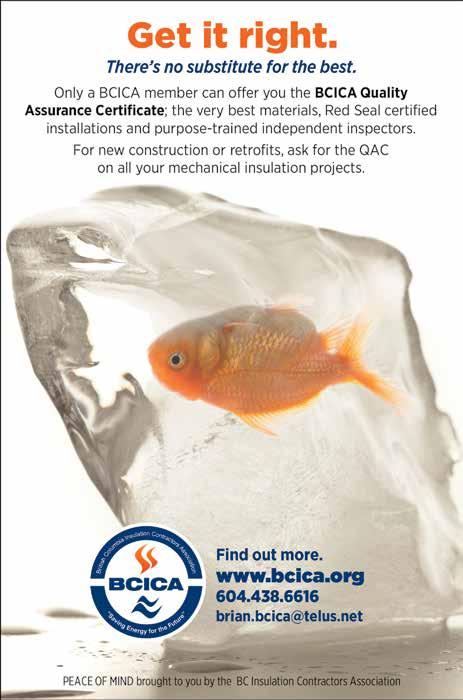
4 minute read
Mechanical insulation – Cost-effective “low-hanging fruit” that saves money and saves energy too
Picking the “low-hanging fruit” is a metaphor commonly used to describe doing the simplest or easiest work first. Maximum gain for minimum effort is also fairly descriptive. However, when budgeting for a new building, or considering a cost-effective solution to saving energy when retro-fitting, finding a simple affordable solution that produces results without taxing the budget can be a daunting task. And, at a time when societal pressures place so much emphasis on saving energy for the future, the task of doing so without driving capital or long-term operational costs through the roof typically falls on the shoulders of educational facility managers and their staff. Mechanical insulation, properly specified and installed by professionals, may be the low-hanging fruit educational facility managers are looking for.
MeChanICaL InsuLatIOn “PayBaCk”
Insulation reduces energy consumption, which means that less fossil fuels are burned to produce that energy. This, in turn, decreases the amount of polluting gases such as carbon dioxide and sulfur dioxide emitted into the atmosphere. Because carbon dioxide is one of the principal greenhouse gases contributing to global warming, and sulfur dioxide is the major component of acid rain, insulation plays a significant role in protecting the environment.
A properly designed and installed insulation system provides an excellent return on investment and quick payback through cost savings. Insulation is a low-risk investment because the savings and the payback can be forecasted with a high degree of accuracy. Insulation is one of the few technologies where the payback for the investment is considered more than acceptable when compared to many other equipment or maintenance purchases. If the insulated system is maintained, the savings from the investment continue for the life of the facility. In fact, it costs more to not insulate properly. Often insulation is paid for by the maintenance budget and then it reduces the operations budget for the life of the
Performance Floors and Walls for Schools and Sports
ERV PARENT
Tarkett iQ Sheet Vinyl Tarkett xf2 Linoleum Altro Safety and Smooth Floors Mondo Sport Rubber Wall Protection Systems
Erv Parent Co. Ltd. 791 Caldew Street, Delta, BC Tel: 604-525-4142 www.ervparent.com system. The return on investment, or payback for an investment in insulation is quick, often from six months to two years. To calculate your specific payback, download a free computer program (called 3E Plus®) at www.pipeinsulation. org or use the insulation calculators created by NIA and available at wbdg.org/design/midg_ calculators.php. (Benefits of Insulation, insulation.org).
ReduCed MOuLd, CORROsIOn, COMPOnent RePLaCeMent
Insulation with a good vapour retarder controls condensation and limits corrosion on cold piping, ducts, chillers, and roof drains. Sufficient thickness is needed to keep the surface temperature above the dew point temperature of the ambient air. When piping and equipment operate at temperatures lower than the ambient air, moisture in the air will condense or freeze on or within the insulation surface, or on the cold pipe surface. unless the system is protected by sufficient thickness and by adequate vapour retarders, the insulation can become wet, causing corrosion, and causing the insulation to become ineffective.
Mechanical insulation of hot and cold-water pipes and ventilation units reduces consumption and costs. Properly installed mechanical insulation saves money as soon as the switch is turned on. It pays for itself in a short period of time. Depending on a building’s size, the cost of installing mechanical insulation can be recovered between
one and five years. Wasted energy costs consumers and taxpayers billions of dollars across the country. And the cost to the environment for future generations will be even higher.
Specifying sufficient insulation thickness with an effective vapour retarder system is the most effective means of providing a system for controlling condensation on the membrane surface and within the insulation system on cold piping, ducts, chillers, and roof drains. Sufficient insulation thickness is needed to keep the surface temperature of the membrane above the highest possible design dew point temperature of the ambient air so condensation does not form on the surface. The effective vapour retarder system is needed to restrict moisture migration into the system through the facing, joints, seams, penetrations, hangers, and supports. By controlling condensation, the system designer may control the potential for mould growth and the potential for health problems resulting from water condensate; as well as corrosion of pipes, valves, and fittings caused by water collected and contained within the insulation system. (Benefits of Insulation, insulation.org).
PeRsOnneL saFety and aesthetICs
Thermal insulation is one of the most effective means of protecting workers from burns resulting from contact with hot or extremely cold piping and equipment. For hot surfaces especially, insulation reduces the surface temperature of piping or equipment to a safer level, resulting in increased worker safety and the avoidance of worker downtime due to injury. As an added bonus, insulation covering exposed air conditioning and plumbing lines gives a finished appearance to a building. (Benefits of Insulation - insulation.org). Mechanical rooms insulated and finished by professionals will no longer be an area to be avoided when officials tour educational facilities.
Mechanical insulation (MI) may be the “low-hanging fruit” you have been looking for. Companies that belong to the British Columbia Insulation Contractors Association (www.bcica.org) are professionals that can apply MI, which helps to reduce GHG, lower energy consumption, reduce condensation, reduce facility operating costs, increase worker safety, and provide managers with a quick ROI. Look for BCICA at the EFMA 2019 conference and trade show in Penticton and ask about the BCICA quality Assurance Certificate (qAC) program designed to provide your building with the ability to save energy for the future. n










